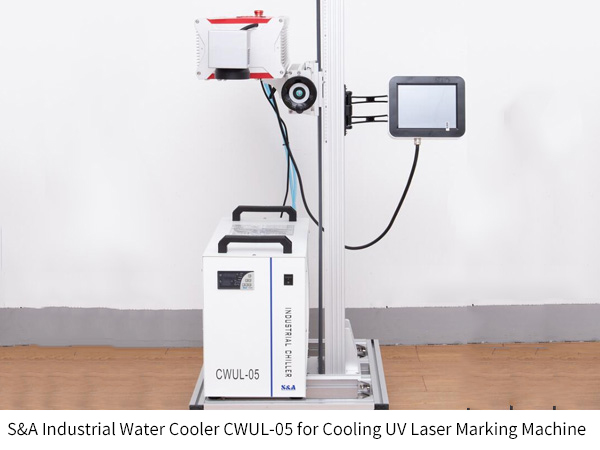![Giunsa pagtabang sa laser marking machine ang mga konsumedor nga mailhan ang tinuod nga maskara sa nawong? 1]()
Sama sa bugas ug mantika, ang maskara sa nawong nahimong kinahanglanon sa atong adlaw-adlaw nga kinabuhi. Bisan pa, ang pipila nga dili maayo nga mga tigbaligya nag-recycle sa gigamit nga mga maskara sa nawong ug gibaligya kini direkta sa mga konsumedor nga wala’y sanitize aron makuha ang dako nga kita. Ang mga peke nga maskara sa nawong dili makapanalipod kanato gikan sa virus. Dugang pa, kini makadaot sa lawas sa tawo. Aron mahibal-an ang tinuod nga mga maskara sa nawong, ang labing direkta nga mga paagi mao ang pagsusi sa gimarkahan nga laser nga anti-peke nga mga label sa mga pakete o sa mga maskara sa nawong mismo.
Ang tinuod nga maskara sa nawong adunay label nga gimarkahan sa laser ug kana nga label mahimong magpakita sa lainlaing kolor nga makita gikan sa lainlaing mga anggulo. Bisan pa, ang peke wala’y pagbag-o sa kolor ug kini giimprinta pinaagi sa pag-imprenta sa inkjet.
Sa tinuud, ang teknik sa pagmarka sa laser dili lamang magamit aron mahibal-an ang tinuud nga maskara sa nawong, mahimo usab kini gamiton aron mahibal-an ang pagkakasaligan sa pagkaon, tambal, tabako, elektroniko ug kosmetiko. Busa nganong gamhanan kaayo kini sa anti-counterfeiting sa lain-laing mga industriya?
Aw, una, atong tan-awon ang prinsipyo sa pagtrabaho sa laser marking machine. Ang makina sa pagmarka sa laser naggamit sa taas nga enerhiya ug taas nga density sa laser beam sa materyal nga nawong. Ang naka-focus nga light beam maghimo sa materyal nga nawong nga mag-alisngaw o mag-usab sa kolor niini ug ang ruta niini dali nga makontrol. Ug ingon niana ang paghimo sa walay katapusan nga mga marka. Ang mga makina sa pagmarka sa laser mahimong mag-print sa lainlaing mga pulong, simbolo ug pattern nga mahimong lebel sa milimetro o micrometer.
Sa wala pa gigamit ang mga makina sa pagmarka sa laser, ang mga marka sa mga pakete kanunay nga giimprinta pinaagi sa pag-imprenta sa tinta. Ang mga marka pinaagi sa pag-imprenta sa tinta dali nga makuha o usbon ug mawala sa paglabay sa panahon. Dugang pa, ang tinta usa ka magamit, nga nagdugang sa gasto sa operasyon ug hinungdan sa polusyon sa kalikopan.
Himoa nga pananglitan ang pakete sa pagkaon. Tungod kay ang mga marka nga giimprinta pinaagi sa pag-imprenta sa tinta dali nga makuha ug usbon, ang pipila nga dili maayo nga mga tigbaligya nag-usab sa petsa sa produksiyon o ang mga ngalan sa tatak sa pagkaon ug gibaligya kini sa mga konsumedor. Ug kana dili maagwanta.
Ang pag-abut sa laser marking machine makatabang sa pagsulbad sa problema sa pag-imprenta sa tinta. Ang paggamit sa laser marking machine sa pakete sa pagkaon mas episyente, mas mahigalaon sa kinaiyahan, mas klaro ug mas malungtaron. Gawas pa, ang mga label sa marka sa laser mahimong konektado sa database sa kompyuter aron ang matag usa sa pamaagi masubay nga maayo.
Sama sa nahibal-an namong tanan, ang mga gigikanan sa laser adunay daghang lainlain ug lainlaing mga gigikanan sa laser adunay lainlaing magamit nga mga materyales. Pananglitan, ang fiber lasers mas angay sa lain-laing mga matang sa metal nga mga materyales; Ang CO2 lasers mas angay sa non-metal nga mga materyales; Ang mga laser sa UV mahimo’g magtrabaho sa parehas nga metal ug dili metal nga mga materyales apan sa mas taas nga katukma ug labi ka gipangayo nga mga aplikasyon.
Sa tinuud, ang mga CO2 laser ug fiber laser dugay nang nakit-an nga naghimo sa pagmarka sa laser. Kining duha ka matang sa mga tinubdan sa laser nagpatunghag kahayag sa infrared wavelength. Ang pagproseso sa pagmarka sa tinuud nagpainit sa mga materyales aron ang mga ibabaw nga materyal mahimong carbonize, bleach o ablate aron ipakita ang lainlaing pagtandi sa kolor. Bisan pa, kini nga matang sa pagpainit makadaot sa nawong sa pakete, labi na ang plastik nga pakete sa industriya sa pagkaon, CO2 laser marking machine ug fiber laser marking machine dili kaylap nga gigamit sa pakete sa pagkaon.
Niini nga kahimtang, ang bentaha sa UV laser mas klaro. Kadaghanan sa mga materyales mas makasuhop sa ultraviolet nga kahayag kay sa infrared nga kahayag ug ang photon energy sa UV laser mas taas. Kung ang UV laser nagtrabaho sa high-molecular polymer, kini makaguba sa kemikal nga bugkos sa materyal ug unya ang nabuak nga materyal nga nawong moalisngaw aron maamgohan ang ablation. Sa niini nga proseso, ang init-apektar zone mao ang medyo gamay ug gamay kaayo nga enerhiya mahimong init nga enerhiya. Busa, kini dili kaayo makadaot sa materyal kay sa CO2 laser ug fiber laser. Ug mao kana ang hinungdan nga ang makina sa pagmarka sa UV laser labi ka sikat sa industriya sa pagkaon ug medikal.
Sama sa gihisgutan sa sayo pa, ang UV laser mas angay alang sa mas taas nga katukma ug mas lisud nga mga aplikasyon. Sa tinuud, sensitibo usab kini sa pagbag-o sa thermal. Ug aron mapadayon ang UV laser sa usa ka lig-on nga sakup sa temperatura, kinahanglan nga adunay sulud nga usa ka cooler sa tubig sa laser. S&A Teyu CWUL series ug CWUP series laser water coolers mao ang sulundon nga mga kapilian. Nagtanyag sila og ultra-tukma nga pagkontrol sa temperatura nga ± 0.2 ℃ ~ ± 0.1 ℃, nga nagpakita sa dako nga abilidad sa pagkontrol sa temperatura. Gawas pa, silang tanan adunay gamay nga gidak-on ug gaan nga gibug-aton, aron madala nimo kini bisan diin nimo gusto. Hibal-i kung giunsa pagtabang sa among mga laser water chiller ang imong negosyo sa pagmarka sa UV laser sa https://www.teyuchiller.com/ultrafast-laser-uv-laser-chiller_c3
![industriyal nga tubig cooler industriyal nga tubig cooler]()












































































































